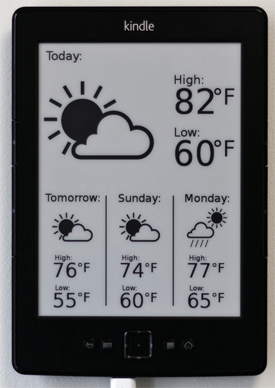Zoltán Kiss- Area Sales Manager - East Europe - Endrich GmbH.
E-paper displays
12 April 2013

Summary :
The Epaper or EPD shortform stands for electronic paper display, which is a kind optoelectronic display technology targeting the same appearance than black ink on paper. Electronic paper is most likely more easily readable than conventional displays, due to the non refreshing stable image, the wider viewing angle, and reflecting ambient light rather than emitting its own light, just like ink printed on paper. An ideal epaper display can be read in direct sunlight without the image appearing to fade. The contrast ratio is similar or sometimes even better compared to newspaper print quality. There are several technological advantages and also disadvantages of the electronic papers, this article is made to give an overview through the displays provided by JHD, a reliable long term display manufacturer partner of Endrich.

Design engineers, who need to provide electronic display functions in order to substitute conventional ink printing on paper, such as creators of e–book readers, electronic time-tables, price tags, need a quality display with low power consumption, excellent contrast ratio as well as wide viewing angle and affordable physical measures. Most of the present E-paper technologies are able to hold static contents for indefinite long time without power consumption, this ultra thin displays need only energy, when new image is requested.

Conventional display technologies use backlight for illumination pixels, while e-paper displays are easily readable even in direct sunlight because of reflecting light like ordinary paper. An EPD is based on the scientific phenomena known as electrophoresis, the movement of electrically charged molecules spread in fluid forced by an applied electric field. As the EPD structure regards, the fluid and the white and black particles are encapsulated into microcapsules of micron diameter. The microcapsules are placed into a layer of liquid polymer, surrounded by two electrodes, the upper one is transparent and grounded, the sheet is divided into pixels, and each pixels are controlled by pixel electrodes located on the bottom side. Even with the transparent protective lamination, the thickness of the complete structure is comparable with the thickness of a strong carton paper. The electrodes are connected to a driver electronics, which then turns the pixel on or off, by applying a voltage to specific electrode. Applying a positive charge to the bottom (pixel) electrode, the generated electric field will force the negative charged white particles to the bottom and giving the pixel a black appearance as the black particles will stay on the surface. Reversing the volta-ge has the opposite effect – the negative white particles are forced to the surface, giving the pixel a white appearance. A more recent concept requires uncharged black particles, which do not move by changing the electric field, but the white ones will set the pixel’s on/off status. As the displays are of reflective type, there is no need to have a backlight, which makes the structure thin and the energy consumption minimal. Depending on the driving method, the display can be positive or negative mode, remaining readable even in direct sunlight, as the reflexion is similar to conventional paper. This means also, that the E-paper is non-readable in darkness without external light source. As being a bi-stabile device, the EPD needs energy only when changing the image. Unfortunately electronic papers have a very low refresh rate compared to other low-power display LCD technologies. This makes it impossible to use them is sophisticated interactive applications (using fast moving menus, mouse pointers or scrolling). Changing of the display contents will result extreme blurring during the transition, and a shadow of an image (ghost image) may be visible after refreshing parts of the screen, which could also result burn-in on the display. Fortunately this could be solved after the screen is refreshed by switching the pixels on an off several times. The real advantage of the technology is shown on static, monochrome display tasks such as electronic price tags, where the extreme low power consumption and the perfect readability dominates, no need to interaction or continuously changing contents. Other advantage is the variable product profile, all kind of shapes could be realized by customization. In some fields the operating temperature range of 0-50 Degree could limit the usage.

Best application areas: advertising & info boards, signboards, greeting cards, product labels, price tags, timetables in bus stops or train stations.
| Share on Facebook | Share on LinkedIn |
References
This article has been published on the following locations:
| # | Media | Link |
|---|---|---|
| 1 | Elektronet 2013/3 | Elektronet : elektronikai informatikai szakfolyóirat, 2013. (22. évf.) 3. sz. 34. old. |
| 2 | Elektronet online | Az elektronikus papír – EPD-kijelzők |


